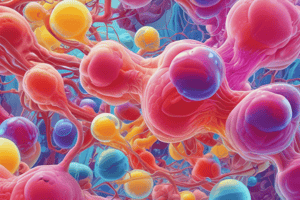Podcast
Questions and Answers
What is the normal total body water (TBW) for men?
What is the normal total body water (TBW) for men?
- 70%
- 55%
- 50%
- 60% (correct)
What is the major cation in the extracellular fluid (ECF)?
What is the major cation in the extracellular fluid (ECF)?
- Potassium (K)
- Chloride (Cl)
- Sodium (Na) (correct)
- Calcium (Ca)
The normal osmolality of body fluids ranges from _____ mOsm/kg water.
The normal osmolality of body fluids ranges from _____ mOsm/kg water.
285-295
What does hyponatremia indicate?
What does hyponatremia indicate?
Hyponatremia is only a concern for elderly patients.
Hyponatremia is only a concern for elderly patients.
What is a common complication due to rapid correction of hyponatremia?
What is a common complication due to rapid correction of hyponatremia?
Match the following fluid and electrolyte disorders with their corresponding definitions:
Match the following fluid and electrolyte disorders with their corresponding definitions:
What is the essential criterion for diagnosing SIADH?
What is the essential criterion for diagnosing SIADH?
A plasma sodium concentration of less than _____ mEq/L indicates hyponatremia.
A plasma sodium concentration of less than _____ mEq/L indicates hyponatremia.
Flashcards are hidden until you start studying
Study Notes
Composition of Fluid Compartments & Total Body Water
- Average fluid composition in the body is 55% - 60%.
- Total Body Water (TBW) percentages by demographic:
- Men: 60% of body weight
- Women: 55% of body weight
- Pediatrics: 70% of body weight
- Geriatrics: 50% of body weight
Distribution of Water
- Major cation in intracellular fluid (ICF): potassium (K).
- Major cation in extracellular fluid (ECF): sodium (Na).
- Sodium-potassium pump regulates cation concentration difference between ICF and ECF.
- Hypothalamus controls TBW and sodium management.
- Osmoreceptors stimulate ADH secretion from the posterior pituitary gland.
- ADH increases water reabsorption by upregulating AQP2 channels in renal collecting ducts.
Plasma Osmolality
- Defined as the number of osmoles per kilogram of water (mOsm/kg).
- Normal osmolality of body fluids: 285-295 mOsm/kg.
- Glucose conversion from mg/dL to mmol/L requires division by 18.
Introduction to Sodium and Water Disorders
- Hyponatremia: low plasma sodium concentration (< 135 mEq/L).
- Hypernatremia: high plasma sodium concentration, resulting from too much sodium or too little water.
- Dysvolemia: sodium disorder; dysnatremia: water/tonicity disorder.
- Hypovolemia: sodium deficit (dehydration); hypervolemia: sodium excess.
Hyponatremia Overview
- Common, especially among the elderly (15-20% inpatient, 7-11% outpatient).
- Associated risks: cognitive decline, falls, fractures, gait instability, mortality, kidney stones.
- Management complications can arise from hyponatremia itself or from rapid correction attempts.
Classification of Hyponatremia
- Mild: serum sodium between 130 and 135 mmol/L.
- Moderate: serum sodium between 125 and 129 mmol/L.
- Severe: profound drops leading to significant clinical manifestations.
SIADH (Syndrome of Inappropriate Antidiuretic Hormone Secretion)
- Characterized by hypoosmolar hyponatremia (plasma osmolality < 100 mOsm/kg).
- Essential criteria include:
- Urinary sodium > 30 mmol/L with normal dietary intake.
- Absence of pituitary, thyroid, adrenal, or renal insufficiency.
- Lack of diuretic use.
- Supplemental criteria include:
- Low serum uric acid and normal serum urea/creatinine levels.
- Failure to correct hyponatremia with saline infusion, improvement through fluid restriction.
Pseudo-hyperkalemia
- Defined as an artificially elevated plasma potassium concentration due to cellular movement.
- Contributing factors:
- Prolonged tourniquet use or repeated fist clenching causing acidosis.
- Delay in processing blood samples leading to hemolysis and potassium leakage.
- Leukocytosis and thrombocytosis can also affect test results.
- Importance of evaluating renal function and reviewing medication lists.
Renal Function Assessment
- Estimations using MDRD equation, Cockcroft-Gault equation, and 24-hour creatinine clearance.
Studying That Suits You
Use AI to generate personalized quizzes and flashcards to suit your learning preferences.




